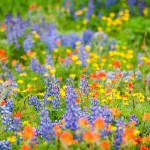
Now that it’s spring, perhaps you are itching to get out in nature and see flowers in all their glory, including the fleeting beauty of wildflowers.
What makes a flower a wildflower? American Meadows explains:
Those that grow in the wild or on their own, without cultivation, are called wildflowers. Wildflowers indigenous to the continent are called “natives.” Others, which may be quite common, but not indigenous, have been introduced from some other part of the world and are referred to as “naturalized.” Both types share one common distinction: They are equipped to grow on their own in nature.

If you plan to seek out these treasures in wilderness this year, here are nine tips from the Wilderness Society to keep in mind:
1. Explore wild places near you. See our recommendations on America’s most spectacular wilderness areas for wildflowers. The U.S. Forest Service also has great recommendations and National Wildlife Refuges can be awesome places where plant life flourishes.
2. Choose trails in valleys or on sunny, south facing slopes. It is important to stay on the trail too, so flowers can continue to flourish off-trail. Follow our “leave-no-trace tips.”
3. Confirm the best times of year to visit. Plants generally begin to bloom as early as March or April in more southern locations, while those in the north may not bud until May or June. A good rule of thumb is to visit before tree foliage begins to completely shade the ground. Elevation makes a big difference too, with alpine meadows often having brief blooming from late July to early August. Deserts are unpredictable, but March or April are recommended. To be sure, you can call ahead to your local national forest, national park or cooperative extension office or look for reports online. The U.S. Forest Service’s interactive wildflower map is a fantastic resource for finding bloom time and wildflower events near you. Here are more resources for wildflower viewing by region: Rocky Mountain region; Pacific Northwest; Intermountain region; Southwestern region; California/Pacific Southwest; Eastern region; Southern region.
4. Venture out immediately after rain. This is especially important if you are in a usually-dry area. Drought can decrease the number and diversity of wildflowers, so you may need to scour if that is the case.
5. Where there are flowers, there are insects. Wear repellant or long-sleeves and pants. You may also want to wear sunscreen, sunglasses and a hat.
6. Become familiar with the most conspicuous, common blooms. The Southwest has bright yellow Mexican poppies and red Indian paintbrushes. In the Pacific Northwest, monkeyflower and mountain lupine are often-sighted.
7. Bring a field guide and other flower-finding gear. In addition to your camera, plan to carry a photo-filled field guide or app to learn about what you find. Look for one that is appropriate for your state or region (Washington, Northeastern U.S, Southern Appalachia, etc.) or the ecological area of interest (desert areas, for example). Avid wildflower seekers will also pack a magnifying glass for closer inspection of petals, leaves and other tiny flower parts.
8. Always observe leave no trace principles to ensure lands remain truly wild. Resist the urge to pick wildflowers—you actually need a permit to do so.
9. Grow a “surprise garden” from the seeds you pick up on your hiking boots. This trick works if you end up walking through mud on your adventure. The forest service offers instructions for preserving flowers and making perfumes as well—but only for flowers you pick at home.

In addition to tips on hunting for wildflowers, the Wilderness Society offers a list of 12 wilderness areas for enjoying wildflowers:
1. Mt. Thielsen Wilderness, Oregon
2. Round Island Wilderness, Michigan
3. Wambaw Swamp Wilderness, South Carolina
4. Mt. Adams Wilderness, Washington
5. Charles C. Deam Wilderness, Indiana
6. Spirit Mountain Wilderness, Nevada
7. Siskiyou Wilderness, California
8. Castle Crags Wilderness, California
9. Pajarita Wilderness, Arizona
10. Maroon Bells-Snowmass Wilderness, Colorado
11. Shenandoah Wilderness, Virginia
12. Great Swamp National Wildlife Refuge Wilderness, New Jersey
Any areas you would recommend?
Interested in wildflower gardening? American Meadows offers wildflower planting guides and how-to info. Wildflowers of the U.S. includes a reference list for wildflower identification in all states and the Lady Bird Johnson Wildflower Center at the University of Texas at Austin has a searchable native plant database, which includes 7,927 plants.
——–
YOU MIGHT ALSO LIKE
15 Plants to Help Save Bees
Top 10 Ways to Help Birds This Spring
7 Tips to Prep for Gardening Season
——–
[source: http://ecowatch.com/2014/04/02/9-tips-for-wildflower-hunting/]

Leave a Reply
You must be logged in to post a comment.